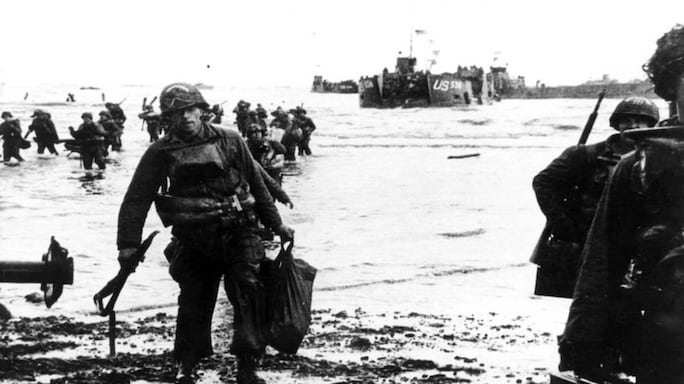- HOME
- /
- Odds and Ends
- /
- Who knew
- /
Remembering D-Day: 7 Fascinating Facts About 6 June That Triggered The Dismantling Of Nazi Germany
Considered the most important day of World War II, when the Allied Forces launched a ground assault against the Nazi forces, it is a day to remember
 American troops land on a beach in Normandy on 6 June, 1944 (Photo: Wikimedia)
American troops land on a beach in Normandy on 6 June, 1944 (Photo: Wikimedia)
The landing of Allied forces on the beaches of Normandy in France on 6 June 1944 is considered the most decisive step that led to the ultimate dismantling of Nazi Germany. It was from here that the Allied troops started taking territory from Hitler's forces. Many military historians say that D-Day marked the beginning of the end of the Hitler regime.
Here are some interesting facts related to D-Day.
The Supreme Commander's Resignation Threat
Months before the D-Day invasion, the Supreme Commander of the Allied forces, Dwight D. Eisenhower threatened to step down if his plan to aerial bomb some railway and road targets in France was not allowed. While British PM Winston Churchill and others were of the view that targets in Germany should be the focus of the aerial campaign, Eisenhower was of the opinion that important French railway tracks, roads, and bridges should be taken out as that would mean that Germans would not be able to mobilize in time when the D-Day invasion takes place. Eisenhower prevailed and so did his plan.
 Gen. Eisenhower interacting with his troops during World War II (Wikimedia)
Gen. Eisenhower interacting with his troops during World War II (Wikimedia)
D-Day: Delayed by a day
War historians have speculated much on the 'D' in D-Day. While some have said that that it stood for 'departure' in naval parlance for ships leaving for war, others have said that it stood for 'decision.' But some historical sources say that it was used by the US military even during World War I. The 'D' simply meant the day on which a mission was to be launched.
The D-Day landings were codenamed Operation Overlord and they were supposed to happen in May, but were postponed as there were logistical issues. Finally, D-Day was scheduled for June 5, 1944. But it had to be postponed yet again, but for just a day. It was predicted that the rough weather conditions at sea would make it difficult for sailing and amphibious landings. Eisenhower delayed it by a day. When the weather improved on 6 June, the assault began.
 A landing craft delivers troops at a beach in Normandy on D-Day (Wikimedia)
A landing craft delivers troops at a beach in Normandy on D-Day (Wikimedia)
To use code names or not
Code names were used extensively to keep the Germans off any plans regarding the attack. For instance, the beaches on the Normandy coast were named ‘Utah’, ‘Omaha’, ‘Gold’, and ‘Sword’ for the attack. ‘Neptune’ was the code name for the landings. As the plans were on, some of these names appeared in a crossword puzzle of an English newspaper in 1944 and the Allied commanders went into a tizzy worrying that these were leaked. But after an extensive investigation, it was found to be a mere coincidence. The code names stayed.
'In case the Nazis won'
Did you know that General Eisenhower, the commanding general of the Allied forces had written a letter that was embargoed to be opened only if his forces were defeated against the Nazis? It was marked “In case the Nazis won.” It read, “Our landings in the Cherbourg-Havre area have failed to gain a satisfactory foothold and I have withdrawn the troops. My decision to attack at this time and place was based upon the best information available. The troops, the air and the Navy did all that bravery and devotion to duty could do. If any blame or fault attaches to the attempt it is mine alone.” He wrote this letter on 5 June, but wrote the date as 5 July. A simple error.
The son of a US President was on the forefront
Brigadier General Theodore Roosevelt Jr., son of US President Roosevelt, at 56 was the oldest man and also the highest-ranked officer among the first wave of soldiers that stormed the beaches of Normandy. A little over a month after D-Day, Theodore Roosevelt Jr. died of a heart attack and he was buried in Normandy.
 Gen Roosevelt Jr. (left) during World War II (WIkimedia)
Gen Roosevelt Jr. (left) during World War II (WIkimedia)
Not everything went according to plan
The landings were delayed by a day due to heavy weather conditions. But the day was not perfect even on 6 June. Many amphibious tanks couldn't make it to the shore because of the choppy seas and the bombings of the German troop positions didn't go as planned due to cloudy weather conditions. The paratroppers were dropped behind the enemy lines but they were not done according to plan, delaying operations.
 An Allied bomber in action on D-Day (Wikimedia)
An Allied bomber in action on D-Day (Wikimedia)
Hitler thought he had a plan
The Allied forces were successful in deceiving Adolf Hitler into believing that Normandy was not their preferred place of attack. While knowing that a large-scale Allied infantry assault would take place on Nazi-occupied France, Hitler thought that the French port city of Calais could be the target. According to war historians Germans installed gun batteries and other troops in Calais, whereas the Allies surprised him in Normandy.






